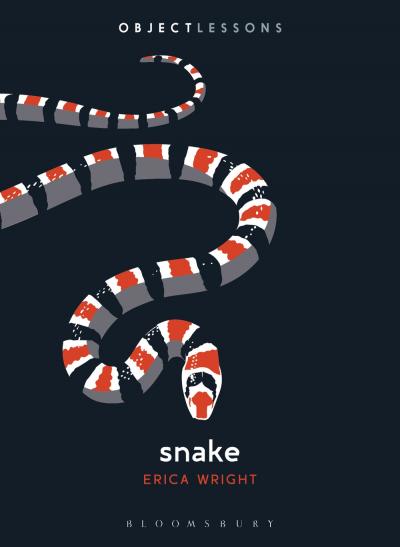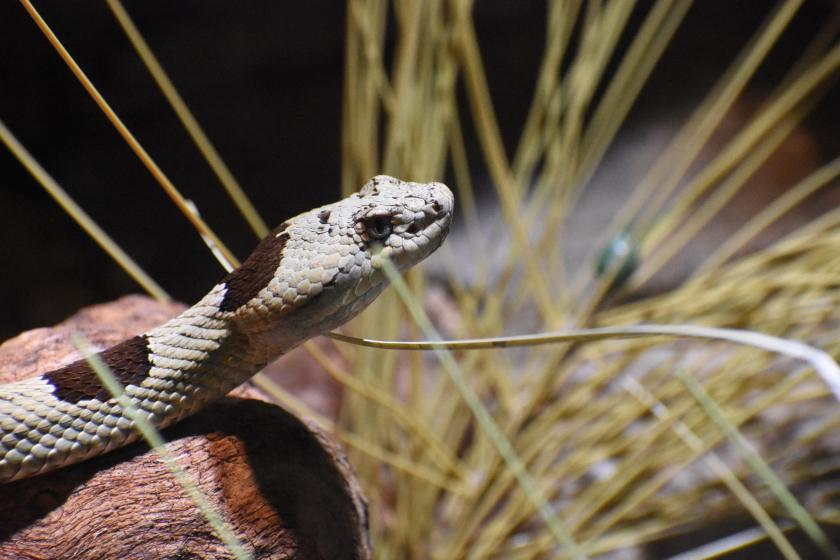Ophidiophobia is one of our most common fears, from the Greek for serpent ('Ophidia'). Writer and editor Erica Wright grew up in Tennessee with periodic interruptions from rattlesnakes, cottonmouths and copperheads, who were spotted slinking around and through the house her family moved to when she was five: "they were there first, had nature's version of squatters' rights." Instead of becoming accustomed to their silent presence, she developed a deep fear of these long-bodied, scaly creatures. Her book, Snake, is a reckoning with that fear: Wright seeks to understand how and why this reptile has become so loaded with cultural weight, a signifier of danger, deceit and unbounded power, as well as fertility and healing.
It’s difficult to pinpoint the moment when I decided to immerse myself in snake stories: grandmothers killing copperheads, rocks stars injecting themselves with venom, and physicists studying sidewinders. Perhaps it started with my 2013 road trip to the Rattlesnake and Wildlife Festival in Claxton, Georgia, or just as likely with seeing my first anaconda – impossibly large and surprisingly active – at the Tennessee Aquarium. A decade ago, I spent a summer obsessed with Titanoboa, a prehistoric marvel clocking in at around forty feet and weighing over a ton. My childhood was filled with close encounters, and I’m sufficiently embarrassed by the number of times I jumped at discarded snakeskins (or even occasionally a thin stick). I better remember the moment my phobia was pricked with sympathy: watching video footage of rattlesnakes being brutalised for sport at what’s called a roundup. I’d never thought much about people killing snakes before, but seeing the animals slaughtered in front of a cheering crowd, hands full of corndogs and hearts full of bloodlust, flipped a switch inside me.
I approached this book with more questions than answers, and let me confess I am no herpetologist. Only two months before my deadline, I learned snakes don’t have eyelids, and I spent the rest of the afternoon in a tailspin, wondering what other basic facts I didn’t know. What I do know, however, what interests me the most, is how deeply humans misunderstand the snake. It features prominently in religion, medicine, history, and culture. From the Laocoön to Snakes on a Plane, this animal often stands in for fear, and yet its venom has been used to treat heart attacks and has the potential to fight strokes and Alzheimer’s. The snake is death and rebirth simultaneously – a crawling contradiction. Popular phrases include “snake in the grass,” “lower than a snake’s belly,” and “a nest of vipers.” But on the other side, dreaming of serpents means you’re coming into money, and they can be found as representations of power on various flags including the Gadsden (“Don’t Tread on Me”) and Mexican national. “Snake” can be synonymous with traitor, back-stabber, and villain, but with recent vernacular changes, we can now say danger noodle, nope rope, and snek. As in, that cute snek has a very boopable nose.

One unexpected perk I discovered while writing about this topic is that people are eager to share. Snakes inspire all manner of anecdotes. When I first moved to Atlanta after thirteen years in New York City, I committed to making new friends, but for some reason, I couldn’t stop talking about roundups. I had learned too much about these events, and it was as if I had some sort of compulsion to mention beauty pageant contestants dipping their hands in rattlesnake blood, anywhere I went. A few strangers were curious, but many more were simply polite about it. On the other hand, a book about snakes more broadly? People wanted to talk. In the country, locals mention finding them in garages or wood piles. In the city, there are rumours of exotic species finding their way into apartment building toilets. A surprising number of folks caught garter snakes and put them in fish tanks when they were kids. Every tidbit reaffirmed that I’m not alone in my fear or in my fascination.
Newspapers are filled with reptilian fodder, and friends send me their favourites. Commuters in Copenhagen once refused to board a bus that sported a realistic-looking boa constrictor for an ad campaign. A spotted python hitched a ride on an overseas flight by hiding in a passenger’s suitcase. A mangrove snake escaped from the Bronx Zoo. I’ve been sent a documentary from the 1960s on a so-called “signs following” Pentecostal church in West Virginia and an article about a decapitated rattlesnake almost killing someone. On one memorable day, six people sent me links to a story about a “virgin birth,” an anaconda at the New England Aquarium having two babies even though she had never mated. All of which is to say, there’s an embarrassment of riches in terms of material, and I tried to focus on the subjects I thought would be most compelling, from Britney Spears’s famous performance with an albino Burmese python to impressive conservation efforts currently being tackled throughout the world. This book explores both the outsized power and outsized stigma assigned to an animal more likely to hide from humans than to harm us.
Quiet, sleek, alert – the snake is unique and beautiful, a natural marvel that I’ve come to believe deserves our admiration. Their scales can achieve perfect camouflage or display such vivid hues that it’s immediately obvious why dragons continue to capture our collective imagination. Here are little dragons not flying above our heads, but exploring the world at our feet. If you are someone like me who shivers or sometimes even shrieks when one crosses your path. I hope your initial reaction can also be followed by a sense of wonder. After all, if vipers can change their colours, why can’t humans change their minds?
- Snake (Object Lessons) by Erica Wright (Bloomsbury, £9.99)
- Read more book reviews on theartsdesk















Add comment